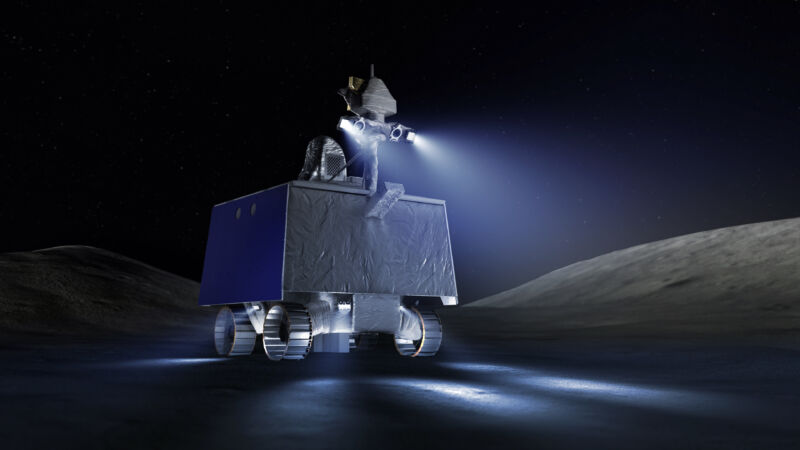The search for ice at the Moon’s poles has loomed large in the field of lunar science since an instrument on an Indian satellite discovered water molecules inside shadowed crater floors more than a decade ago. NASA is now assembling a golf cart-size rover to drive into the dark polar craters to search for ice deposits that could be used by future astronauts to make their own rocket propellant and breathable air.
“A large group of people have been working on this idea for 10-plus years,” said Anthony Colaprete, project scientist for NASA’s Volatiles Investigating Polar Exploration Rover (VIPER) mission.
Earlier this year, engineers at NASA’s Johnson Space Center in Houston started building the rover’s chassis. In June, the space agency formally approved VIPER’s team to move into full-scale assembly and testing ahead of the rover’s scheduled launch in November 2024.
A new kind of rover
The four-wheel rover looks different compared to NASA’s nuclear-powered robots exploring Mars. VIPER is designed to drive into dark craters, places where sunlight hasn’t reached for billions of years. Scientists have detected evidence that those cold, shadowed crater floors harbor water ice at or near the surface, where it could be harvested by astronauts.
“Because it goes into dark places, it is the first rover with headlights,” Colaprete said Tuesday in a presentation at the NASA Exploration Science Forum. The LED headlights will cast a blue tint on the Moon’s charcoal-coloured landscape.
VIPER will also be operated differently than NASA’s Mars rovers. It takes a radio signal between 5 to 20 minutes to travel at the speed of light between Earth and the red planet, but just a few seconds to make the trip to the Moon. That means scientists can control VIPER more like a drone. “We do real-time science,” Colaprete said.
The rover will take daring trips into the eternally dark craters, relying on battery power for up to 50 hours during each traverse that moves VIPER beyond the rays of the Sun, always near the horizon at the lunar poles. The 1,000-pound (450-kilogram) rover will go into hibernation when the wobble of the Moon’s rotation causes the south pole to shift out of the view of Earth for two weeks, cutting the direct communications link.
NASA announced the VIPER mission in 2019. VIPER builds on the Resource Prospector mission, which NASA canceled in 2018 as the agency pivoted to a commercial approach for robotic lunar exploration. That resulted in NASA’s Commercial Lunar Payload Services (CLPS) program, which has a roster of companies eligible to bid on “task orders” to ferry science and tech demo payloads to the Moon.
One of those companies is Astrobotic, which NASA selected in 2020 to deliver VIPER to a landing site near Nobile crater, a 45-mile-wide (73-kilometer) impact basin at the Moon’s south pole. The roughly $200 million commercial delivery arrangement allows Astrobotic to design and build the lander to carry VIPER to the Moon, a system that NASA would have developed—at greater cost—for the original Resource Prospector mission.
Astrobotic selected SpaceX’s Falcon Heavy rocket to launch the company’s Griffin lander, which will shepherd the VIPER rover to the Moon.
The entire mission is projected to cost about $500 million, including the rover, its science payloads, and Astrobotic's contract, which covers the cost of the Falcon Heavy launch.
“We’re chugging along,” Colaprete said Tuesday. “We’re now less than one year from delivery to Astrobotic for integration onto their Griffin lander. So the launch is on the horizon. Our nominal launch is November 10, 2024, with currently a five-month mission duration. We’re looking at ways where we might be able to extend that out a month or two beyond that.”
Two of VIPER’s three science instruments have already been integrated into the vehicle in Houston. Then the ground team will attach solar arrays, four 20-inch (50-centimeter) wheels, and a 3-foot-long (1-meter) drill that will probe into the lunar surface to measure the depth of any ice deposits. A suite of cameras will also be installed on the vehicle, as will a mast extending some 8 feet (2.5 meters) over the ground.
Water ice holds a lot of promise for space exploration. The hydrogen and oxygen could be used to generate electricity, rocket fuel, or converted into air to supply pressurized habitats on the Moon. A NASA instrument on India’s Chandrayaan 1 orbiter mission first detected the tell-tale chemical signature of water at the Moon’s poles in 2009.
But first, scientists need to know exactly where the water is located and how easy it is to reach.
“We are going to a place where there is enhanced hydrogen,” Colaprete said. “I personally have no doubt we will see water in some form or another, it’s just a matter of the concentrations.”



3175x175(CURRENT).thumb.jpg.b05acc060982b36f5891ba728e6d953c.jpg)

Recommended Comments
There are no comments to display.
Join the conversation
You can post now and register later. If you have an account, sign in now to post with your account.
Note: Your post will require moderator approval before it will be visible.